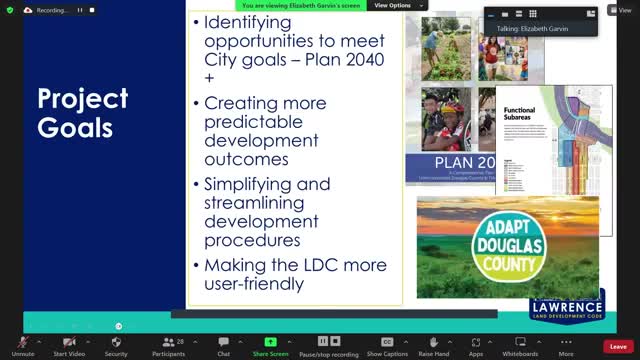City launches ambitious plan to reshape development regulations
July 03, 2024 | Lawrence, Douglas County, Kansas

This article was created by AI summarizing key points discussed. AI makes mistakes, so for full details and context, please refer to the video of the full meeting. Please report any errors so we can fix them. Report an error »

In a recent government meeting, city officials outlined significant updates to the land development code aimed at implementing Plan 2040 and enhancing urban development processes. The project, which began in June 2022 and is set to conclude in July 2024, seeks to create a more predictable and user-friendly regulatory environment for development in the city.
Key changes discussed include expanding housing options by allowing various residential types—such as duplexes, triplexes, and townhomes—across all residential districts. This shift aims to accommodate the growing population and promote affordable housing through smaller lot developments. Additionally, the code introduces minimum density requirements in residential areas to encourage higher density living, aligning with the city’s policy goals.
The meeting also highlighted updates to neighborhood design standards, ensuring that new developments harmonize with existing community aesthetics. Specific design standards will guide infill projects, maintaining the character of neighborhoods while allowing for necessary growth.
Environmental considerations are a priority in the updated code, with regulations designed to protect sensitive areas, including watersheds and stream corridors. New standards will enforce buffers around natural features and promote low-impact development practices to manage stormwater effectively.
Active transportation initiatives were also emphasized, with the elimination of minimum parking requirements in favor of parking maximums. This change encourages developers to assess market needs for parking rather than adhering to strict mandates, potentially freeing up land for more productive uses. The code will also ensure connectivity for pedestrians and cyclists, promoting a multimodal transportation approach.
Importantly, the updates will not alter existing zoning for individual properties, preserving current land uses and allowing single-family homes to remain a viable option in residential districts. The city aims to maintain stability for property owners while fostering opportunities for future development.
Overall, these regulatory changes reflect the city’s commitment to sustainable growth, community engagement, and environmental stewardship as it prepares for the future. Public review and feedback on the proposed changes are ongoing, with officials encouraging community involvement in shaping the city’s development landscape.
Key changes discussed include expanding housing options by allowing various residential types—such as duplexes, triplexes, and townhomes—across all residential districts. This shift aims to accommodate the growing population and promote affordable housing through smaller lot developments. Additionally, the code introduces minimum density requirements in residential areas to encourage higher density living, aligning with the city’s policy goals.
The meeting also highlighted updates to neighborhood design standards, ensuring that new developments harmonize with existing community aesthetics. Specific design standards will guide infill projects, maintaining the character of neighborhoods while allowing for necessary growth.
Environmental considerations are a priority in the updated code, with regulations designed to protect sensitive areas, including watersheds and stream corridors. New standards will enforce buffers around natural features and promote low-impact development practices to manage stormwater effectively.
Active transportation initiatives were also emphasized, with the elimination of minimum parking requirements in favor of parking maximums. This change encourages developers to assess market needs for parking rather than adhering to strict mandates, potentially freeing up land for more productive uses. The code will also ensure connectivity for pedestrians and cyclists, promoting a multimodal transportation approach.
Importantly, the updates will not alter existing zoning for individual properties, preserving current land uses and allowing single-family homes to remain a viable option in residential districts. The city aims to maintain stability for property owners while fostering opportunities for future development.
Overall, these regulatory changes reflect the city’s commitment to sustainable growth, community engagement, and environmental stewardship as it prepares for the future. Public review and feedback on the proposed changes are ongoing, with officials encouraging community involvement in shaping the city’s development landscape.
View full meeting
This article is based on a recent meeting—watch the full video and explore the complete transcript for deeper insights into the discussion.
View full meeting
